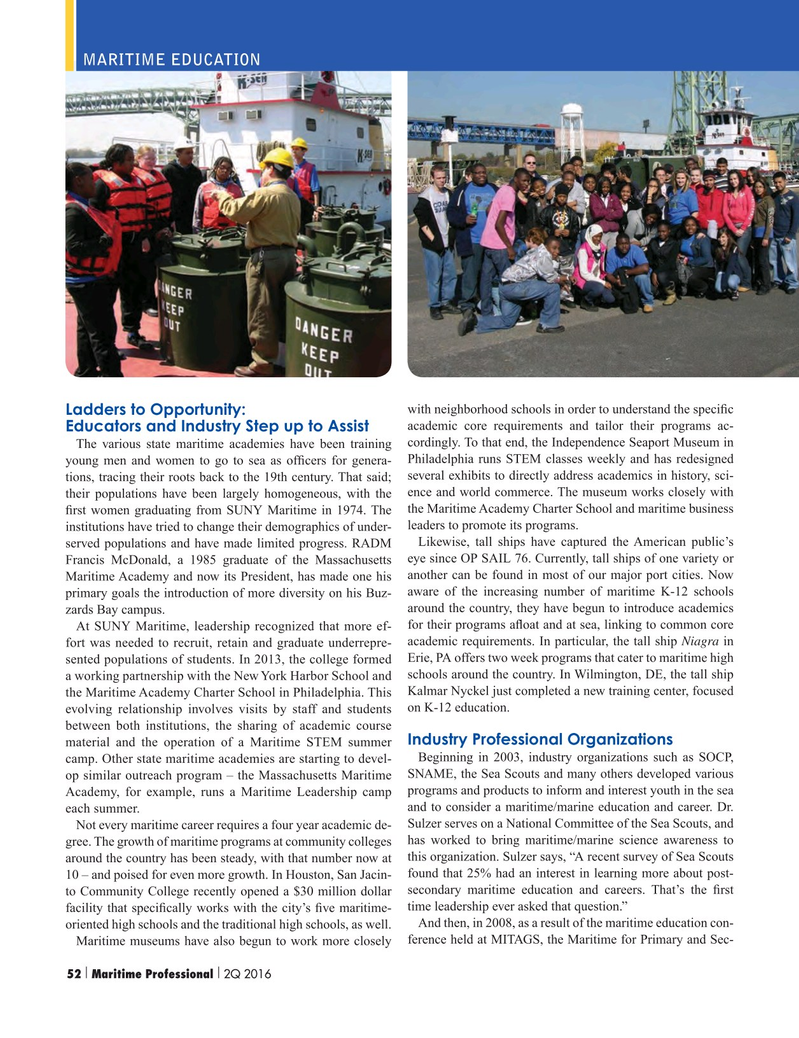
Page 52: of Maritime Logistics Professional Magazine (Q2 2016)
Energy Transport & Support
Read this page in Pdf, Flash or Html5 edition of Q2 2016 Maritime Logistics Professional Magazine
MARITIME EDUCATION with neighborhood schools in order to understand the speci? c
Ladders to Opportunity: academic core requirements and tailor their programs ac-
Educators and Industry Step up to Assist
The various state maritime academies have been training cordingly. To that end, the Independence Seaport Museum in
Philadelphia runs STEM classes weekly and has redesigned young men and women to go to sea as of? cers for genera- tions, tracing their roots back to the 19th century. That said; several exhibits to directly address academics in history, sci- their populations have been largely homogeneous, with the ence and world commerce. The museum works closely with ? rst women graduating from SUNY Maritime in 1974. The the Maritime Academy Charter School and maritime business leaders to promote its programs.
institutions have tried to change their demographics of under-
Likewise, tall ships have captured the American public’s served populations and have made limited progress. RADM
Francis McDonald, a 1985 graduate of the Massachusetts eye since OP SAIL 76. Currently, tall ships of one variety or
Maritime Academy and now its President, has made one his another can be found in most of our major port cities. Now aware of the increasing number of maritime K-12 schools primary goals the introduction of more diversity on his Buz- around the country, they have begun to introduce academics zards Bay campus. for their programs a? oat and at sea, linking to common core
At SUNY Maritime, leadership recognized that more ef- academic requirements. In particular, the tall ship Niagra in fort was needed to recruit, retain and graduate underrepre- sented populations of students. In 2013, the college formed Erie, PA offers two week programs that cater to maritime high a working partnership with the New York Harbor School and schools around the country. In Wilmington, DE, the tall ship the Maritime Academy Charter School in Philadelphia. This Kalmar Nyckel just completed a new training center, focused evolving relationship involves visits by staff and students on K-12 education.
between both institutions, the sharing of academic course
Industry Professional Organizations material and the operation of a Maritime STEM summer
Beginning in 2003, industry organizations such as SOCP, camp. Other state maritime academies are starting to devel- op similar outreach program – the Massachusetts Maritime SNAME, the Sea Scouts and many others developed various
Academy, for example, runs a Maritime Leadership camp programs and products to inform and interest youth in the sea and to consider a maritime/marine education and career. Dr. each summer.
Sulzer serves on a National Committee of the Sea Scouts, and
Not every maritime career requires a four year academic de- has worked to bring maritime/marine science awareness to gree. The growth of maritime programs at community colleges around the country has been steady, with that number now at this organization. Sulzer says, “A recent survey of Sea Scouts found that 25% had an interest in learning more about post- 10 – and poised for even more growth. In Houston, San Jacin- to Community College recently opened a $30 million dollar secondary maritime education and careers. That’s the ? rst time leadership ever asked that question.” facility that speci? cally works with the city’s ? ve maritime-
And then, in 2008, as a result of the maritime education con- oriented high schools and the traditional high schools, as well.
Maritime museums have also begun to work more closely ference held at MITAGS, the Maritime for Primary and Sec- 52 Maritime Professional 2Q 2016| | 50-63 Q2 MP2016.indd 52 5/19/2016 11:46:13 AM

 51
51

 53
53
